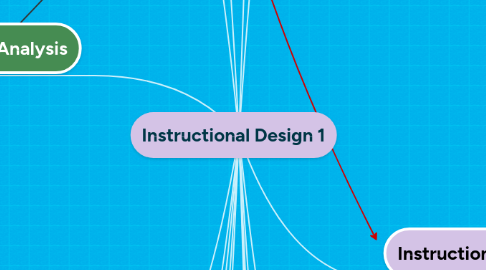
1. Instructional Problem
1.1. Fundamental Components of Instructional Design - Framework for instructional planning
1.1.1. Learners
1.1.2. Objectives
1.1.3. Methods
1.1.4. Instructional Planning
1.1.4.1. Instructional Designer
1.1.4.2. Subject Matter Expert
1.1.4.3. Evaluator
1.1.4.4. Addie
1.1.4.4.1. Analysis
1.1.4.4.2. Design
1.1.4.4.3. Development
1.1.4.4.4. Implementation
1.1.4.4.5. Evaluation
1.1.5. Evaluation
1.1.5.1. Summative
1.1.5.2. Formative
2. Need for Instruction
2.1. Needs Assessment
2.1.1. Normative Needs
2.1.2. Comparative Needs
2.1.3. Felt Needs
2.1.4. Expressed Needs
2.1.5. Anticipated Needs
2.1.6. Critical Incident Needs
2.2. Goal Analysis
2.2.1. Identify an Aim
2.2.2. Set Goals
2.2.3. Refine Goals
2.2.4. Rank Goals
2.2.5. Refine Goals Again
2.2.6. Make a Final Ranking
2.3. Performance Assessment
3. Learner and Contextual Analysis
3.1. Context
3.1.1. Contextual Analysis
3.1.1.1. Collecting Data
3.1.1.2. Analyzing Data
3.1.2. Types of Context
3.1.2.1. Orienting Context
3.1.2.1.1. Learner Factors
3.1.2.1.2. Organizational Factors
3.1.2.1.3. Immediate Environment Factors
3.1.2.2. Instructional Context
3.1.2.2.1. Learner Factors
3.1.2.2.2. Immediate Environment Factors
3.1.2.2.3. Organizational Factors
3.1.2.3. Transfer Context
3.1.2.3.1. Learner Factors
3.1.2.3.2. Immediate Environment Factors
3.1.2.3.3. Organizational Factors
3.2. Learner Analysis
3.2.1. General Characteristics
3.2.2. Specific Entry Characteristics
3.2.3. Learning Styles
4. Generative Strategies
4.1. Recall
4.2. Integration
4.3. Organizational
4.4. Elaboration
5. Pre-instructional Strategies
5.1. Pretests
5.2. Behavioral Objectives
5.3. Overviews
5.4. Advance Organizer
6. Conditions of Learning
6.1. Internal
6.2. External
7. Nine Events of Instruction
7.1. Gaining Attention
7.2. Informing learners of the objective
7.3. Stimulating recall of prior knowledge
7.4. Presenting the stimulus
7.5. Providing learning guidance
7.6. Eliciting performance
7.7. Providing feedback
7.8. Assessing performance
7.9. Enhancing retention and transer
8. Theories
8.1. Learning Theory
8.2. Behavioral Learning Theory
8.3. Cognitive Theory
8.4. Social Learning Theory
8.5. Instructional Theory
8.6. Instructional Design Model
9. Task Analysis
9.1. Topic Analysis
9.1.1. Content Structures
9.1.1.1. Fact
9.1.1.2. Concepts
9.1.1.3. Principles and Rules
9.1.1.4. Procedures
9.1.1.5. Interpersonal Skills
9.1.1.6. Attitudes
9.2. Procedural Analysis
10. Instructional Objectives
10.1. Objective Domains
10.1.1. Cognitive Domain
10.1.1.1. Bloom's Taxonomy
10.1.1.1.1. Knowledge (Remembering)
10.1.1.1.2. Comprehension (Understanding)
10.1.1.1.3. Application (Applying)
10.1.1.1.4. Analysis (Analyzing)
10.1.1.1.5. Synthesis (Evaluating)
10.1.1.1.6. Evaluation (Creating)
10.1.2. Psychomotor Domain
10.1.2.1. Dave's Model
10.1.2.1.1. Imitate
10.1.2.1.2. Manipulate
10.1.2.1.3. Precision
10.1.2.1.4. Articulation
10.1.2.1.5. Naturalization
10.1.2.2. Simpson's Model
10.1.2.2.1. Perception
10.1.2.2.2. Set
10.1.2.2.3. Guided Response
10.1.2.2.4. Mechanism
10.1.2.2.5. Complex Overt Response
10.1.2.2.6. Adaptation
10.1.2.2.7. Origination
10.1.2.3. Harrow's Model
10.1.2.3.1. Reflex Movement
10.1.2.3.2. Basic-fundamental Movements
10.1.2.3.3. Perceptual Abilities
10.1.2.3.4. Physical Abilities
10.1.2.3.5. Skilled Movements
10.1.2.3.6. Nondiscursive Communication
10.1.3. Affective Domain
10.1.3.1. Behavioral Learning Theory
10.1.3.2. Cognitive Dissonance Theory
10.1.3.3. Affective-Cognitive Consistency
10.1.3.4. Social Judgement Theories
10.1.3.5. Social Learning Theory
10.1.3.6. Functional Theories
10.1.3.7. Krathwohl's Taxonomy
10.1.3.7.1. Receiving/Attending
10.1.3.7.2. Responding
10.1.3.7.3. Valuing
10.1.3.7.4. Conceptualizing/Organizing
10.1.3.7.5. Characterizing by value
11. Instructional Sequencing
11.1. Learning Related Sequencing
11.1.1. 5 Student Learning Concepts
11.1.1.1. Prerequisite skills
11.1.1.2. Teaching the known
11.1.1.3. Level of difficulty
11.1.1.4. Content based on interest
11.1.1.5. Development Theory
11.2. World-Related Sequencing
11.2.1. Spatial Relations
11.2.2. Temporal Relations
11.2.3. Physical Attributes
11.3. Concept-Related Sequencing
11.4. Elaboration Theory Sequencing
11.4.1. Content Expertise Sequencing
11.4.2. Task Experience Sequencing
12. Developing Instruction
12.1. Cognitive Load Theory
12.1.1. Intrinsic Load
12.1.2. Extrinsic Load
